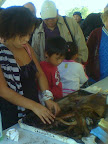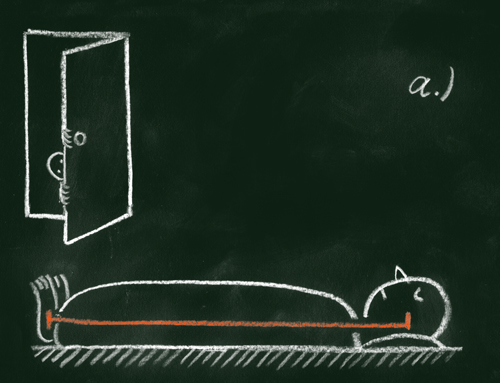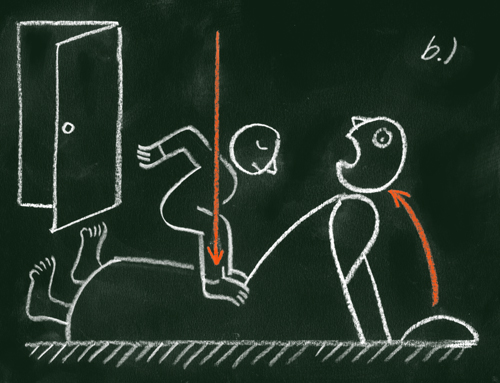USA Festival of Science and Engineering 2010—just a fraction of what was there
By Peggy Ashbrook
Posted on 2010-10-30
I had a good time at the USA Science and Engineering Festival Expo in Washington, D.C. on October 23 and 24. I was really impressed with the large number of people attending—great diversity of age, sex, ethnicity, race, language, families and individuals. I saw one of my neighbors there, a young mom with 3 kids and her mother—someone I didn’t realize was interested in science or engineering, and I saw a lot of STEM* geek t-shirts. Well attended, the festival was crowded even at 4:30 on Sunday just before closing.
*STEM is an acronym for Science, Technology, Engineering and Math.
The number of people in attendance made it difficult for young children to get access to some booths, but by going with the flow they could see some really cool stuff. Hopefully the cool stuff will inspire children to take science classes, join science clubs, and pursue science inquiry at home and in informal settings.
My favorite exhibits were:
Dissecting the Humboldt squid–we were there before the dissection but got to touch it and learn all the external anatomy–Squids for Kids.
Making a “Puff-mobile” using (at most) 3 straws, 4 lifesavers, a 9cm x 12cm piece of paper, 2 paper clips and 50 cm of tape and then racing it by blowing it (windpower)–The Society of Women Engineers.
The non-Newtonian fluid pool where kids ran across the cornstarch and water mixture (except for the child who stopped and sank to her ankles)–Michigan Technological University.
Meeting Johannes Kepler and George Washington Carver, and Sid the Science Kid.
Other engaging booths:
The stink bug and cricket CO2 output measuring activity at NSTA was cool for preteens and up.
NASA’s 3-D Mars landscape, puzzles of the Earth, and telescope viewings of the Sun.
A giant Newton’s cradle made with volleyballs.
Ancient ice from the Arctic, sea ice, glacier ice, and permafrost ice, .
“Maggot Monet” creating art by letting flesh eating fly larvae crawl through paint drops, putting them back on the paper with forceps when they wander too far.
What did you see?
Peggy
- Read more about USA Festival of Science and Engineering 2010—just a fraction of what was there
I had a good time at the USA Science and Engineering Festival Expo in Washington, D.C. on October 23 and 24. I was really impressed with the large number of people attending—great diversity of age, sex, ethnicity, race, language, families and individuals. I saw one of my neighbors there, a young mom with 3 kids and her mother—someone I didn’t realize was interested in science or engineering, and I saw a lot of STEM* geek t-shirts. Well attended, the festival was crowded even at 4:30 on Sunday just before closing.
Popular classroom resources at the KC conference
By Claire Reinburg
Posted on 2010-10-29
 The on-site Science Store at the Kansas City Area Conference has been bustling. Books and gear items garnering a lot of attention include John Haysom and Michael Bowen’s new NSTA Press book Predict, Observe, Explain: Activities Enhancing Scientific Understanding and Michael Klentschy’s Using Science Notebooks in Middle School. Susan Koba and Anne Tweed’s Hard-to-Teach Biology Concepts and Anne’s Designing Effective
The on-site Science Store at the Kansas City Area Conference has been bustling. Books and gear items garnering a lot of attention include John Haysom and Michael Bowen’s new NSTA Press book Predict, Observe, Explain: Activities Enhancing Scientific Understanding and Michael Klentschy’s Using Science Notebooks in Middle School. Susan Koba and Anne Tweed’s Hard-to-Teach Biology Concepts and Anne’s Designing Effective 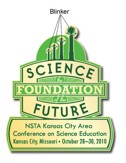 Science Instruction are topics of discussion and interest, buoyed by those authors’ workshop sessions at the conference. Lots of science teachers at the conference are sporting the conference pin, which features blinking versions of Kansas City’s iconic “Sky Stations” sculptures atop the convention center. Items from the “I Love Science” and “Science Matters” NSTA gear lines continue to be popular, as well. All of these NSTA Press books and gear items are available online at the Science Store.
Science Instruction are topics of discussion and interest, buoyed by those authors’ workshop sessions at the conference. Lots of science teachers at the conference are sporting the conference pin, which features blinking versions of Kansas City’s iconic “Sky Stations” sculptures atop the convention center. Items from the “I Love Science” and “Science Matters” NSTA gear lines continue to be popular, as well. All of these NSTA Press books and gear items are available online at the Science Store.
Bits and pieces for October
By Mary Bigelow
Posted on 2010-10-28
 The fall is my favorite season — the colorful leaves, the cooler weather, the different position of the sun that gives everything a slightly different look. For most of us, it’s also the beginning of a new school year and a good time to explore new ideas for our classrooms.
The fall is my favorite season — the colorful leaves, the cooler weather, the different position of the sun that gives everything a slightly different look. For most of us, it’s also the beginning of a new school year and a good time to explore new ideas for our classrooms.
Our colleagues in the NCTE (National Council of Teachers of English) and IRA (International Reading Association) have a great resource to help students with reading and writing: ReadWriteThink. I used the menu in the left margin to search on “Standard Lessons” and the theme “Science” and found a list of 54 lessons that relate science and language arts on topics such as vocabulary, reading nonfiction texts, informational writing, and critically evaluating Internet resources. You can further finetune by grade level. Many lessons have intriguing titles such as Digging Up Details on Worms: Using the Language of Science in an Inquiry Study, Digital Reflections: Expressing Understanding of Content Through Photography, and Using THIEVES to Preview Nonfiction Texts. Most of these are for K-8, although if you have high school students who are English language learners or have difficulty with high school text, you may find some helpful lessons here.
The bonus here is that if you enter a keyword, the site also accesses resources from the Verizon Thinkfinity partners. This list can be futher finetuned by grade level. I entered the keyword keyword “cell” and filtered with 9-12, science, and lessons. I got a list of 21 results, although not all were actual lessons (some were “updates” which are podcasts).
The folks at Edutopia, one of my favorite sites, have a new Home to School Connections Guide. This free document (you do need to register) has many suggestions for involving and communicating with parents and other caregivers. You may also be interested in a blog entry on the Edutopia site How to Teach Students to Think Like Scientists.
I always find something interesting and relevant in the Educational Leadership journal. For example in the October 2010 issue I found articles such as The Words Students Need, Reviving Reteaching, and Cell Phones as Teaching Tools. You don’t have to be a member to access these articles. (Thank you, ASCD!).
The SciLinks webwatchers are continually expanding the database with new resources. Check out some new entries on topics such as Ciliophora, Stoichoimetry, Chemical Safety, or Lunar Eclipses. And you can always review the Reasons for the Seasons this fall.
Photo by MLB: Central Park in the Fall.
Teaching and learning about wind energy
By Claire Reinburg
Posted on 2010-10-28
On an appropriately blustery morning in Kansas City, the short course “Wind Energy for the Science Classroom,” led by Joe Rand of The KidWind Project in St. Paul, MN, supplied participants with background information and sample classroom lessons on the rapidly growing field of wind energy. Joe began with an overview of where the industry and the technology now are in this alternative energy area. About 2% of our energy now comes from wind, and Midwestern states like Minnesota, Kansas, and Michigan are rapidly expanding the manufacture of turbines and equipment to harness this resource. Course participants had the opportunity to then build a turbine using PVC pipe, a crimping hub, multimeter, motor, and other materials from the supplies provided. The unique element of the lesson for students is that they design the turbine’s blades out of everyday materials and then perform various blade-design experiments. Efficient blades are a key part of generating power from a wind turbine, and students learn that it takes thought and time to make good blades that function efficiently. They can make adjustments to the blades, such as shortening them, changing the pitch, or using fewer blades to improve the performance of their turbines. KidWind has great resources and links on their website that make it easy to incorporate hands-on activities on the science behind wind energy. Perhaps today’s lessons will inspire tomorrow’s engineers and specialists in the burgeoning field of renewable energy.
On an appropriately blustery morning in Kansas City, the short course “Wind Energy for the Science Classroom,” led by Joe Rand of The KidWind Project in St. Paul, MN, supplied participants with background information and sample classroom lessons on the rapidly growing field of wind energy. Joe began with an overview of where the industry and the technology now are in this alternative energy area. About 2% of our energy now comes from wind, and Midwestern states like Minnesota, Kansas, and Michigan are rapidly expanding the manufacture of turbines and equipment to harness this resource.
Blogging resumes for NSTA Chapters and Associated Groups community
By Teshia Birts, CAE
Posted on 2010-10-26
Hello everyone! I would like to take this opportunity to introduce myself —I’m Teshia Birts, one of the newest members of the NSTA staff. You may have seen the message Howard Wahlberg sent about me a couple of weeks ago and I’m really looking forward to working with the chapter/associated group leaders and staff.
I know it has been a few months since we have communicated to you through our blog. I hope to blog at least weekly…providing you with info from the National office, but also insight and advice on association-related issues. If you are struggling with governance, leadership development, membership retention/recruitment, etc., feel free to contact me and I will provide you with as much guidance as I possibly can.
Recently a chapter reached out to us with questions about their tax-exempt status and we were able to provide them with the help they needed. (Want to learn more? Log in to the NSTA Communities and check out Moira Fathy Baker’s financial management presentation from the 2010 NCSE meeting.)
I will also be on the road the next few weeks attending all three NSTA Area Conferences. If you plan to attend, please let me know or feel free to stop by the Membership Booth on NSTA Avenue.
You can always reach me at tbirts@nsta.org. I look forward to working with all of you. Talk to you soon!
Hello everyone! I would like to take this opportunity to introduce myself —I’m Teshia Birts, one of the newest members of the NSTA staff. You may have seen the message Howard Wahlberg sent about me a couple of weeks ago and I’m really looking forward to working with the chapter/associated group leaders and staff.
Physics filtered through a three-year-old
By NSTA Web Director
Posted on 2010-10-26
“Whether we like it or not,” Christoph Niemann writes at the New York Times website, “human life is subject to the universal laws of physics.” He goes on to illustrate:
My day, for example, starts with a demonstration of Newton’s First Law of Motion.
It states, “Every body continues in its state of rest, or of uniform motion in a straight line…”
“…unless it is compelled to change that state by forces impressed upon it.”
We think you’ll enjoy reading the entire piece, tongue-in-cheekingly entitled “Unpopular Science.”
“Whether we like it or not,” Christoph Niemann writes at the New York Times website, “human life is subject to the universal laws of physics.” He goes on to illustrate:
Cycles and interactions
By Mary Bigelow
Posted on 2010-10-24
Many science curriculum guides are identifying “big ideas” (or essential questions, underlying themes, understandings) that provide context or a framework for helping students to make connections between concepts within and between subject areas. Some students are able to make their own connections, but many others may need a little assistance to get to this “aha” moment. And when that moment occurs and the light bulb goes on (to use an old metaphor), it’s a rewarding event for a teacher.
This issue focuses on suggestions to help students understand how cycles of land, air, water, air, and living things are interconnected, and how they relate to real-life events and issues.
Living in Pennsylvania, I was immediately interested in Connect the Spheres with the Coal Cycle. The article includes lots of background on the formation of coal and how the formation, extraction, and use are related in the carbon cycle (with connections to climate change and acid rain). An extensive list of websites is provided (suitable for WebQuests or other projects). More resources can be in found in the SciLinks Coal Mining.
Speaking of projects, take a look at The Take Action Project article with examples on how to help students discover their connections to nature and to turn this learning into do-able and relevant projects. Examples of connecting science to personal interests can be found in Physics Fun with Toy Cars, The Science of Soil Textures (with connections to racing, gardening, and other outdoor activities).
It’s always interesting to ask students where something comes from. The article Banning the Bottle (this month’s “Green Science entry) looks at issues related to the bottled water that is so commonly used—from the source of the water, plastics, bottling equipment and labor, transportation, and recycling vs. disposing in landfills. Students can see how even as something as mundane as a throwaway water bottle is connected to various processes.
Even a class activity such as a test can be considered a cycle, as described in the “Teacher’s Toolkit” article Strategies for the Meaningful Evaluation of Multiple-Choice Assessments. The author describes each step in the process, from sharing tips for test taking, scoring, analyzing errors (on the part of both teachers and students), which can lead to reteaching or revising the test as the cycle continues to the next unit. The process described by the author is a teacher-friendly (and student-friendly) analysis, and several graphics illustrate the process.
Transporting Students Into Thin Air shows how students can experience the connections between science and communications skills (reading, writing, discussion) and includes examples of student work (which I always like to see) and a “grading” sheet. Taking the Time to Read Aloud also illustrates connections with science and reading, showing how middle-schoolers are not too old to enjoy and learn from teacher read-alouds. The author includes some suggested materials, and NSTA Recommends would have more ideas for appropriate trade books to share with students. SciLinks also has a list of online resources related to reading and writing in science.
NSTA’s SciLinks has several categories at the middle school level that have online resources for learning about cycles and connections:
Finally, the article Finding Learning Beneath the Surface: Monitoring Student Progress with Science Practices Learning Progressions is definitely connected to the processes describe in this month’s Science and Children. The author describes a way to assess students’ ability to observe, measure, graph, diagram, investigate, design, explain, analyze, and model. The progressions are in four levels, ranging from “beginning” to “proficient.” This looks like an excellent way to diagnose student needs and to help students self-monitor their development of inquiry process skills.
President Obama invites you to the USA Science and Engineering Festival
By NSTA Web Director
Posted on 2010-10-22
The big event takes place on the National Mall and around the country this weekend. Here’s your personal invitation:
[youtube]http://www.youtube.com/watch?v=PDxTw1sUKvk[/youtube]
See you there! Be sure and stop by NSTA’s area (NM-1 booths 116-124, located near the Capitol reflecting pool and near 3rd Street and Madison Drive). The folks from National Lab Day will be there as well (PA-13 booths 1251 and 1253, near Pennsylvania Avenue and 13th Street).
The big event takes place on the National Mall and around the country this weekend. Here’s your personal invitation:
[youtube]http://www.youtube.com/watch?v=PDxTw1sUKvk[/youtube]
Science fairs and alternatives
By Mary Bigelow
Posted on 2010-10-22
 I have my eighth-grade honors physical science classes do traditional science fair projects (trifold board display with research essay and lab report). This year there has been some discussion within our department about giving students alternatives. The students would be able to choose what type of project they want to do (so those who are interested could still pick a traditional project), but we’d like to explore other options.
I have my eighth-grade honors physical science classes do traditional science fair projects (trifold board display with research essay and lab report). This year there has been some discussion within our department about giving students alternatives. The students would be able to choose what type of project they want to do (so those who are interested could still pick a traditional project), but we’d like to explore other options.
—Carolyn, Chesterfield, Virginia
When students hear the term “science fair,” their reactions may range from cheers of excitement to groans of despair. Science fairs take a lot of time, effort, and resources. So regardless of format, it’s important to determine which science standards or learning goals will be met by having students participate. In my experience, middle school students are naturally enthusiastic, especially if they have choices of activities. But their enthusiasm can get sidetracked if they have too many options.
For some students, traditional projects that involve independent research can be a motivating experience leading to career decisions and scholarship opportunities. They can also be frustrating—especially for younger students—if they do not have much experience with designing and conducting authentic investigations (other than following directions for a “cookbook” activity). I’ve seen science fairs in upper elementary and middle schools in which all participants were required to use the same template that supposedly followed “the” scientific method. The rubrics often had little room for independent thinking, and I wonder how much students learned about inquiry processes from these projects.
For alternatives, check out the resources of the National History Day (NHD) competition This competition has several categories reflecting the authentic work of historians: documentary, exhibit, paper, performance, or website. Each category is described in detail in the rulebook, with directions and rubrics, and could be modified for science projects (e.g., substituting experimental research or descriptive study for the documentary category). If you ever attend a NHD showcase, you won’t find any pretzel-stick log cabins!
Another alternative might be to take advantage of the many “competitions” involving students (or teams of students) in real-world projects related to research, design, and problem solving. Some examples include Toshiba/NSTA Exploravision, Invention Convention, Odyssey of the Mind, Science Olympiad, Kids’ Inquiry Conference, Siemens We Can Change the World Challenge, eCyberMission, and special event projects such as It’s Elemental.
Many colleagues have shared excellent ideas for traditional and alternative science projects in NSTA journals, such as the December 2007 issue of Science and Children and the March 2004 issue of Science Scope. These articles are also good resources for secondary teachers, especially if your students are science fair novices or if you want some fresh ideas. The articles have timelines, rubrics describing high quality projects, and suggestions for helping students who may have few resources at home. They also describe online science fairs, science expos, multimedia presentations, themed projects, mini-conferences, and other nontraditional “fairs.” To save time, I’ve assembled a shared collection of NSTA resources on Science Fairs and Alternatives in the NSTA Learning Center.
SciLinks also has a list of websites with many ideas for both traditional and nontraditional projects. For example, Science Buddies has a “topic selection wizard” that guides students through the process of selecting and fine tuning a topic. This site has sections and resources for both students and teachers.
Keep in mind nontraditional projects or competitions can require as much work on your part as a traditional fair (and perhaps more, if you need several types of guidelines and rubrics). As with traditional projects, you’ll need to consider how much work will be completed outside of class. Do your students have resources at home? How much parental “support” will be acceptable? Will all students be required to do a project (and at the same time)? Will you allow students to work together? Will you have a public event to display the projects? Will students compete with each other?
It’s exciting and rewarding to see students’ creativity, especially when they can relate science to personal interests. One of my seventh graders was very interested in writing, and for her project she created a collection of poems related to forest ecology. She entered one in a local writing project and won a medal for it. The English teacher and I were very proud of her accomplishment.
Photo: www.flickr.com/photos/rbowen/3266847462/in/photostream/
Francis's blog on all things science education
By Francis Eberle
Posted on 2010-10-19
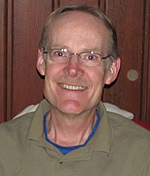
NSTA Executive Director Francis Eberle
Welcome to my blog about issues and concerns to science educators and science education. At least once each month I will introduce a new topic that I hope will generate some discussion, and also respond to your ideas, comments, and suggestions.
I want to start with a new report that recently was released by the President’s Council of Advisors on Science and Technology (PCAST) titled Prepare and Inspire: K–12 Education in Science, Technology, Engineering and Math (STEM) for America’s Future. PCAST advises President Obama on key policy issues, so one might think there would be more attention to what the report had to say about improving K–12 STEM education. Only one outlet (Education Week) covered the report in any depth. I urge you to take a look at this report. One question on my mind is whether we are reaching the Sputnik moment in this country with the PCAST report, or is this just another report in a long line of reports destined for the shelf. Do you think this report is destined to the dusty bookcase, or will/can it change anything about science education?
There are two important ideas in this report that I hope will rise above the current din of efforts to improve science education. The first idea is captured by the word Inspire in the report’s title. It refers to the nature of science as being a discipline that helps the human spirit and mind expand through discovery and imagining “what could be” and “why.” I have to wonder, as science educators, have we lost our way from inspiring students about the potential science holds for creativity and discovery? Have we done this because of the push to prepare students for tests and to meet next year’s expectations, instead of helping students understand what science is capable of doing and how it helps us understand the world? Do you think we have lost the idea of wonderment in science?
The second idea that I think is of particular importance for science educators is the recommendation that states recognize and reward the top five percent of the nations STEM teachers by creating a STEM master teacher corps. We surveyed via NSTA Express and asked what you thought, and 64 percent of respondents agreed it was a good idea. Think of what a difference this would make in science education. If we use an estimate of 200,000 science educators, five percent would mean 10,000 experts, mentors, coaches, and resource people would be in schools and centers across the country supporting science education. They would be in represented in every congressional district (a political move in the report, but not a bad idea). I think this is an actionable recommendation. What do you think?
Rather than me going on about these ideas, let’s start a discussion—tell me what you think about the PCAST report and the three questions above.
—Francis

NSTA Executive Director Francis Eberle



